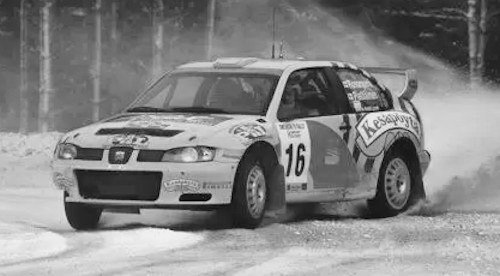SEAT Córdoba WRC
 |
|
|
Make |
Seat |
|
Years |
1998 to 2000 |
|
Class |
Race car |
|
Homologation |
World Rally Car |
|
Engine |
1,995 cc |
|
Transmission |
Six-speed sequential |
|
Drive |
4-wheel drive |
|
Wheelbase |
2,443 mm (96.2 in) |
The SEAT Córdoba WRC is a rally vehicle based on the SEAT Córdoba built from the late 1990s.
History
With World Rally Car approval . It was built by SEAT to participate in the World Rally Championship in the official team, the SEAT World Rally Team which is managed by its sports department, SEAT Sport . The car debuted in the 1998 Finland Rally and participated from that year until 2000 The car never got a victory but three podiums: in New Zealand and Great Britain in 1999 and in the 2000 Safari . It had three evolutions and its last official participation was in the Rally of Great Britain of 2000 .After its withdrawal from the World Cup, the SEAT Córdoba WRC continued to appear in world championship events in the hands of private pilots, but on their destination were the national and regional championships, mainly from Spain, both in asphalt and land competitions.
The development of the Córdoba WRC was not easy since the vehicle was one of the longest, next to the Škoda Octavia WRC of all cars in the category and was also the one with the most limited wheelbase. The distribution of weights was an inconvenience because of the long overhangs which unbalanced the car. The engine block started from the second generation Volkswagen Golf , the same one that had been used in the Ibiza Kit Car although with the addition of turbo, in line with the regulations. The engine was located on the front axle but slightly ahead of it, which influenced the behavior of the moving car, with clear understeer. As for the gearbox, it was located transversely to the engine, which did not help the distribution of weights. The rest of the car's elements were commissioned from different external suppliers: the engine to Dany Snobeck (a French expilot specialized in circuit car motors), the change to the British company Hewland (who designed the carcass, since the sprocket did it the Seat itself), the gearbox and the transmission scheme to Prodriveand the Öhlins Swedish shock absorbers that were mounted with a McPherson scheme on both axes. The result was not as expected for the engineers: Snobeck had trouble finding a good response in the engine at low and medium speeds and the great pending issue of Córdoba was the sub-turning behavior, something that was tried to solve in the successive evolutions. As for the differentials Seat mounted an active type in the center and front, while the rear were initially mechanical but later changed to an electronic one. One of the things that the brand managed to correct was the cooling, initially quite poor due to the forced position of the turbo, which improved in the second evolution when the front of the car presented a new aesthetic line.
The Córdoba WRC, like its contemporaries, had a turbocharged 1995 cc engine, four cylinders in line and 16 valves that developed a power of 300 hp limited by regulations through a flange on its turbo. It had, but not in its standard version, four-wheel drive and a six-speed sequential gearbox.
The first version of Córdoba debuted in the 1998 Finland Rally and its best result was a third place in New Zealand in 1999 by Toni Gardemeister . This first version was not exempt from development problems due to the lack of experience of SEAT in all-wheel drive models and external suppliers.The second evolution debuted just one year later, in the 1999 Finland Rally and tried to solve some of the reliability problems of its first version, especially its low response to low revolutions. For this Garret incorporated a new turbo. They also worked on the suspensions, on aerodynamics, such as the introduction of a new rear wing, and the cooling and aesthetic appearance was provided with a new front, according to the version of the street model. With two podiums, Great Britain 1999 and Safari 2000 , it was the most successful version of all. 5
The third and final evolution that the Córdoba WRC told, debuted in the 2000 Finland Rally and its best result was the sixth place that Gardemeister obtained in Australia that same year. The car presented some changes, mainly aesthetic as the new front, but it also changed all the internal wiring.
